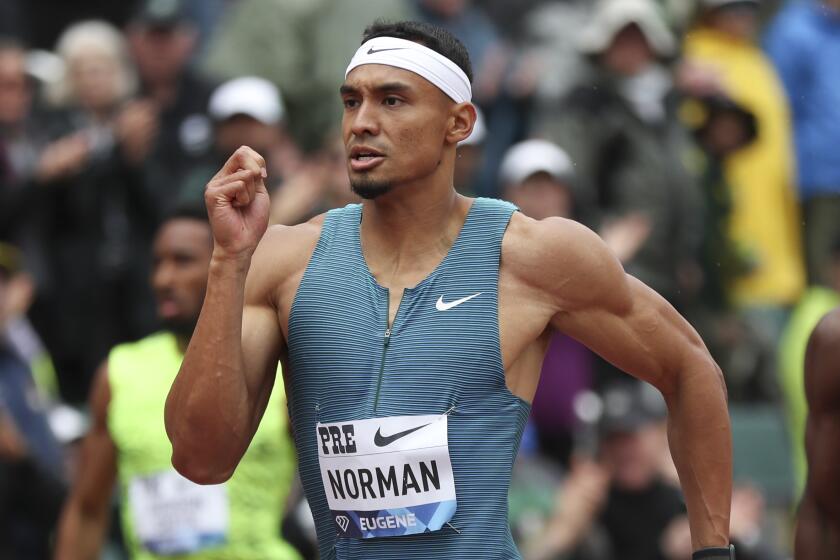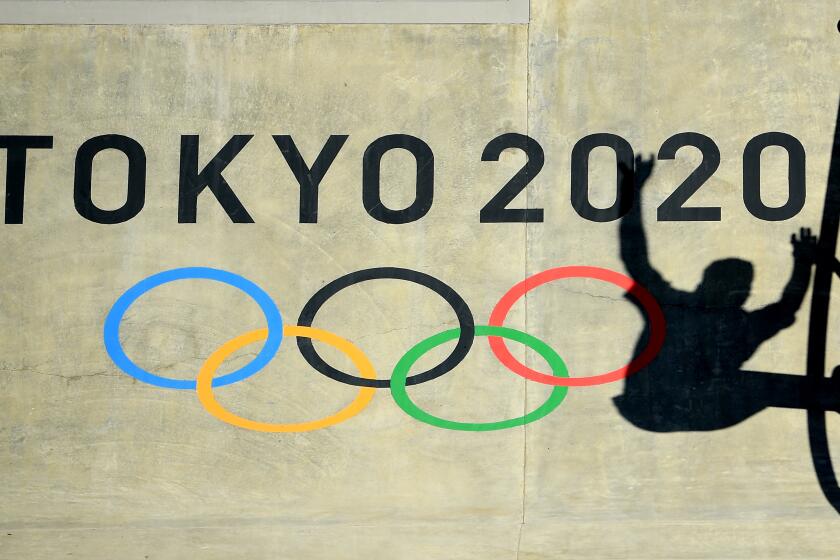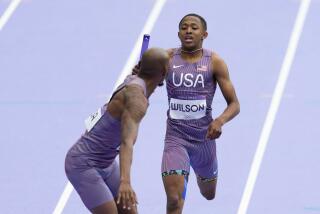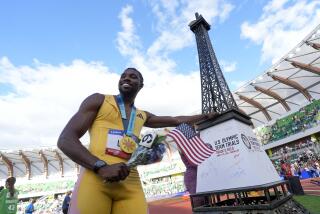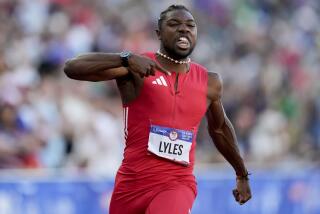The next Usain Bolt? Erriyon Knighton isn’t scared by comparisons and expectations
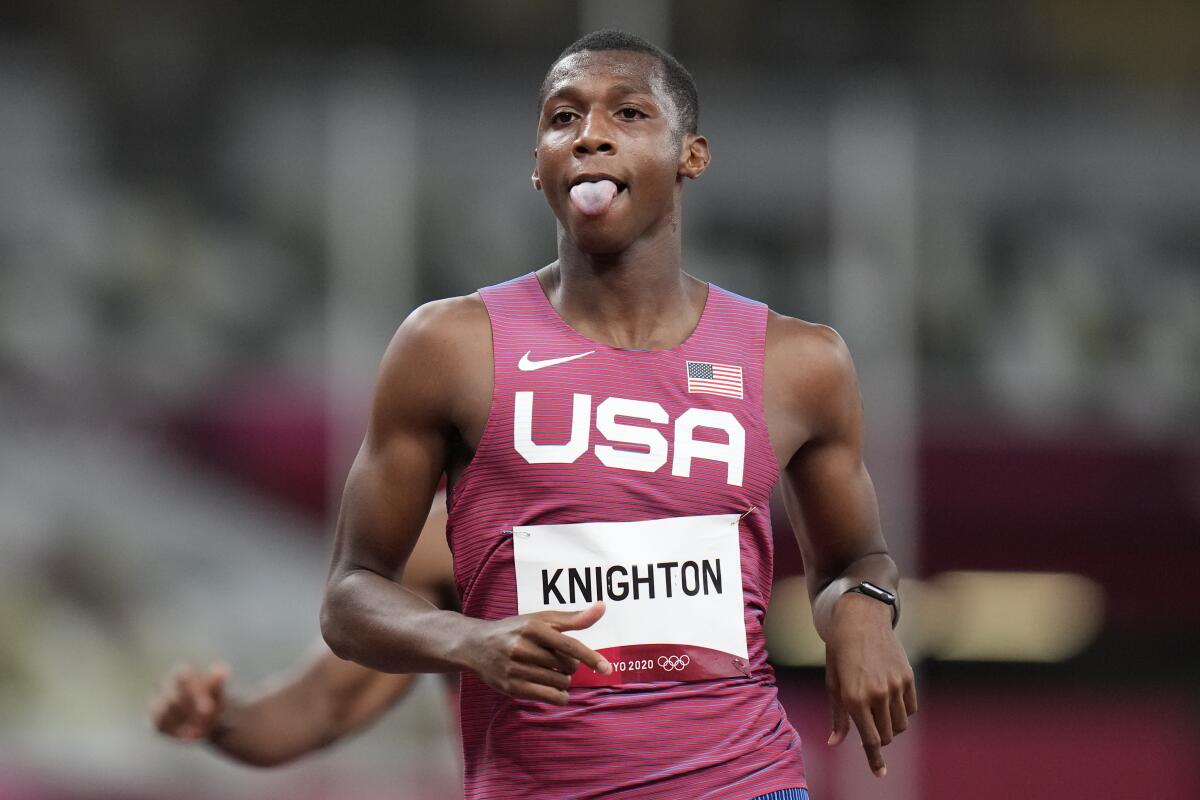
EUGENE, Ore. — But for a scrolling thumb, the world’s fastest teenager was, for once, unmoving.
Erriyon Knighton had just slipped out of a late-May news conference here into an empty adjoining hotel conference space, where he settled into a director’s chair, slouching in Adidas athleisure. Since his fourth-place finish at the Tokyo Olympics in the 200 meters at just 17, then running 19.49 seconds, the fourth-fastest time ever over the distance this spring, at just 18, Knighton had grown used to questions that are a variation on a theme — what is it like to be this fast, this young?
Asked how he would interview himself, he looked up from his phone in the quiet room with an interested grin.
“I would probably just ask, ‘What do you do on meet day, what you listen to to get hype?’ ” Knighton said. “‘Do you ever get scared?’ Yeah, that’s a good one. Because I damn sure don’t get scared.”
Michael Norman is trying to shake off a disappointing Tokyo Olympics and disrupted training because of the pandemic and injuries ahead of summer meets.
The sky-high expectations, the comparisons to Usain Bolt — Knighton isn’t running from any of it as the U.S. track and field championships begin this week at Eugene’s Hayward Field, where Knighton can secure berths in July’s world outdoor championships by finishing in the top three in the 100 or 200 meters.
“He’s fearless,” said Ato Boldon, the NBC Sports analyst and four-time Olympic medalist sprinter. “If you look back at him going through the Olympic trials last year, you’ll see it’s almost like yeah, I respect Noah [Lyles] and these other guys who have the names but I don’t have to beat them, they have to beat me.”
Knighton’s literal burst onto track and field’s scene has put him, in some ways, into a different race — a two-man contest against the year-by-year progression of Bolt, the sport’s eight-time Olympic gold standard-bearer for speed, who himself was a tall, teenage prodigy. Bolt’s under-18 and under-20 world records for 200 meters now belong to Knighton.
In 2003, by age 16, Bolt had run the 200 in 20.13; Knighton in 20.33. By age 17, Bolt had improved to 19.93, and Knighton, last year, clocked 19.84. Bolt’s best at 18 was 19.99. Knighton smashed that with his 19.49 clocking in Baton Rouge, La., a number Boldon initially thought had been misreported.
“Nobody’s going to run 19.4 and certainly not Erriyon Knighton,” Boldon recalled thinking. “And then I saw the videotape and I just went O.M.G. — look at this kid!”

Only Bolt, fellow Jamaican Johan Blake and American Michael Johnson had run faster over 200 meters, what Knighton calls his “money event.” Yet while Bolt ran his world record of 19.19 on the day before his 23rd birthday, Blake was 21 when he ran 19.26 and Johnson was 28 when, at the 1996 Olympics, he set his then-world record of 19.32, Knighton still had high school classes to attend after his statement run.
“Obviously it’s cool to get compared to one of the — I was gonna say one of the greatest, I mean the best ever,” Knighton said. “People compare me to him, I try not to think about it too much. At the end of the day I’m not him, my name ain’t Usain Bolt, I’m Erriyon Knighton and I’m just paving the way every day for myself and trying to make my own name.”
How Knighton made his name would seem to flout every rule of a youth sports industrial complex that attempts to mold future stars by offering regimented training and travel teams for the elementary school crowd.
Knighton said his family didn’t have excess money for sports fees as a child, so he played on an uncle’s youth football team because of its discount. From 8 to 13, Knighton described a “big gap of not doing nothing” organized other than middle school football.
”...Sometimes you’ve just got to take chances. I mean, as you can see right now, I took the right chance.”
— Erriyon Knighton, on focusing on track instead of football
He hadn’t explored track’s possibilities seriously until he was a 14-year-old freshman, when Joseph Sipp, a football and track coach at Tampa’s Hillsborough (Fla.) High who had seen his speed during football conditioning drills, insisted Knighton turn out.
“He kind of fought me on it a little bit, ‘I’m not a track athlete,’ ” Sipp told a camera crew from his school district last year. “Track practice came, he didn’t show up. I went to him in school and said, ‘You’re coming out for track, there’s no ifs, ands or buts about it, you’re running track and I don’t want to hear anything.”
Only two years later, at 16, he’d signed a professional contract with Adidas and began training under renowned University of Florida coach Mike Holloway and a high school coach, Jonathan Terry, a deal that tested the 6-foot-3 Knighton’s expectation to use football as his ticket to the pros as a wideout.
“I could take the risk of track and go right now to the big league, or I can just wait four years and play football and go to the NFL,” Knighton said of his deliberations before forgoing his high school and collegiate eligibility. “But I was just like, sometimes you’ve just got to take chances. I mean, as you can see right now, I took the right chance.”
By last August, friends and teachers gathered inside Hillsborough High and watched Knighton become the youngest American to finish in the top four of an individual track and field event at the Olympics since 1928, according to ESPN research.
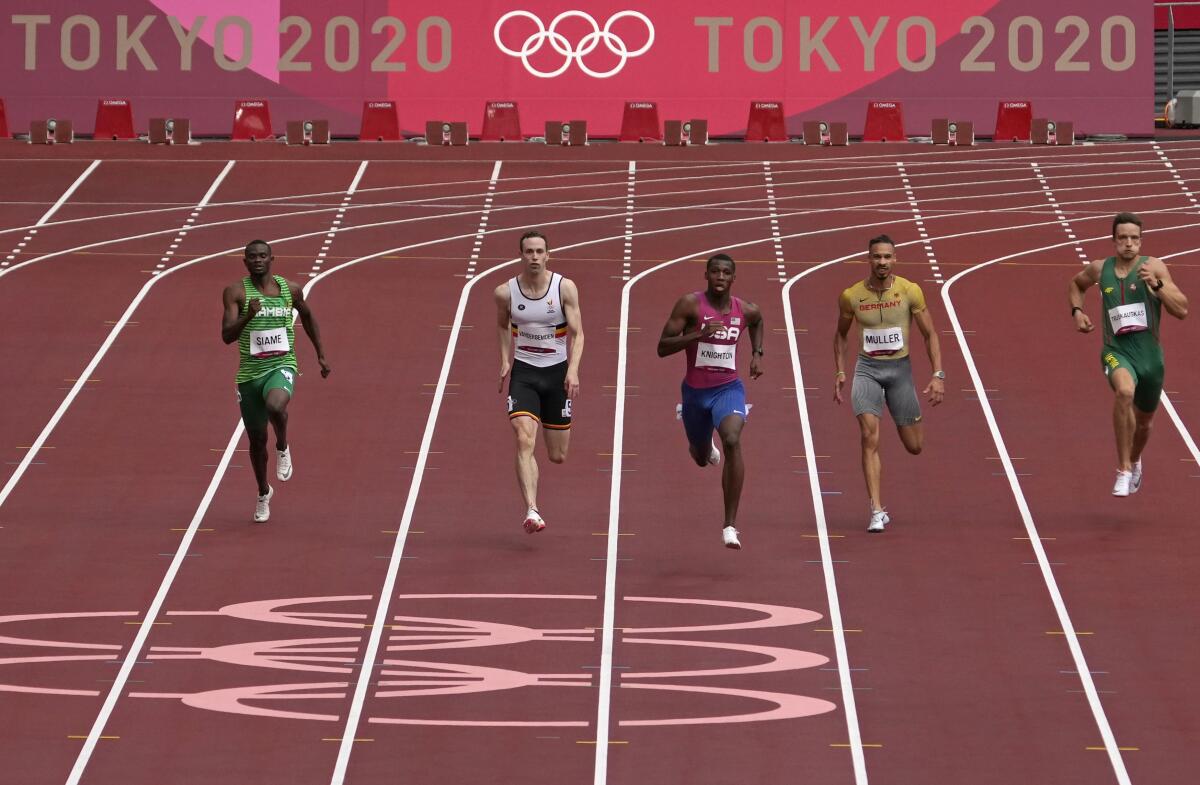
Boldon says he hopes Knighton’s example leads other fast football-focused athletes to consider track’s pathway to the pros. He also knows Knighton’s fast start isn’t a predictor his times will continue to drop and his medal count will grow, calling track and field’s under-18 and under-20 record books filled with those who peaked as teens. Every sport has such cautionary stories, Boldon said, but “in track and field, we’re almost known for it.”
“But that [future] didn’t occur to me when I saw him because to me I’m like this kid is starting at 19.4,” Boldon said. “He’s literally behind three people in the history of the event. Let’s say he doesn’t get 100% of what he has in him, let’s say he gets 90% of it.
“If he gets 90% of what I think he has in there, then he should be a world-record-holder before it’s all said and done.”
Bolt dominated three summer Olympics, from Beijing to London to Rio de Janeiro. If Knighton makes three consecutive Olympic teams, he’ll arrive in Los Angeles in 2028 and still be only 24 — with possibly still time for an NFL opportunity afterward, much as how two-time Olympic hurdler Devon Allen has landed a wide receiver contract with the Philadelphia Eagles despite not playing football since 2016.
Tokyo Olympics organizers have placed the final cost of the Games at $13 billion, about twice of what was forecast when the IOC awarded them in 2013.
Knighton has only recently begun lifting weights to add strength. In an acknowledgement of his newcomer status, he said he learns something about sprinting every day. Already, however, he said his competitors should have learned plenty about him. In a sport rife with tales of older sprinters attempting to intimidate younger runners in the call room, minutes before a race, Knighton said no one has tried him yet.
“Within that race if you try to intimidate me, it’s not going to work,” he said. “You try to get in my head, it’s not going to work. If you talk to me, I’m not going to say nothing to you before the race so you really gonna have to see me on the track.
“You gonna win some, you gonna lose some, but at the end of the day it’s just about going into the race not scared.”
More to Read
Go beyond the scoreboard
Get the latest on L.A.'s teams in the daily Sports Report newsletter.
You may occasionally receive promotional content from the Los Angeles Times.

